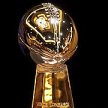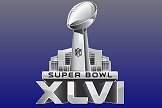
| The Complete Super Bowl |
| Established April 1, 1999 • A Division of Hoffco, Inc. • Not endorsed by the NFL |
| Games • MVPs • Standings • Records • Rings • Programs • Pre-Super Bowl • Sitemap • About |


|
|  |
The first AFL-NFL World Championship Game on January 15, 1967, between Green Bay and Kansas City--"Super Bowl" did not become official until III in 1969-- was the most anticipated pro football game ever.
The reputation of the mighty NFL against the upstart "Mickey Mouse League," as the AFL had been dubbed by NFL adherents, was at stake, and NFL owners exhorted Packers coach Vince Lombardi to win--and win big--because raw feelings still existed after the intense war the two leagues had fought since 1960.
The game was played in the 94,000-seat Los Angeles Memorial Coliseum. Though the game was blacked out locally, only 61,946 attended after L.A. newspapers ranted against the "exorbitant" $12 ticket price and instructed fans how to rig home TV antennas to pirate the signal from stations outside Los Angeles.
There was competition from every angle. Two networks--NBC and CBS--televised the game across the country and used their own announcers (Ray Scott, Frank Gifford, Jack Whitaker and Pat Summerall for CBS; Curt Gowdy and Paul Christman for NBC).
During the game, each league's official football was used whenever its champion was on offense, and there was a mixed crew of officials from both leagues. Norm Schachter of the NFL was the referee.
The game attracted scores of media, who were entertained by Kansas City defensive back Fred Williamson. The "Hammer" boasted he would manhandle the Packers. "Two hammers to [end Boyd] Dowler, one to [end Carroll] Dale should be enough," he bragged.
He should have gone after end Max McGee, instead.
McGee made a spectacular one-handed catch of a pass that Bart Starr (the game's MVP) threw slightly behind him and ran 23 yards to complete a 37-yard play for the game's first touchdown. But the Chiefs, undaunted and clever with their multiple offense, soon tied it on a pass from Len Dawson to running back Curtis McClinton. Green Bay came right back for a 14-7 lead in the second quarter on Jim Taylor's 14-yard run, but the Chiefs Mike Mercer kicked a field goal, and Green Bay led only 14-10 at the half.
The upstart Chiefs clearly had "won" the first half because they'd kept Green Bay's offense off balance by stacking their linebackers behind the tackles, making them hard to block on running plays. On offense, Kansas City's play- action passes made the Packers' pass rush and coverage seem tentative. Lombardi ordered an all-out attack by his offense and his defense in the second half.
On the Chiefs' first possession of the second half, linebackers Lee Roy Caffey and Dave Robinson blitzed and hit Dawson as he threw. The ball floated into the hands of free safety Willie Wood, who returned it 50 yards. On the next play, Elijah Pitts scored on a 5-yard rush, and a second half blowout ensued. Starr passed 13 yards to McGee for his second touchdown; McGee caught 7 passes for 138 yards that day after grabbing only 4 all season. Pitts's second touchdown in the last quarter polished off the scoring in the Packers' 35-10 victory.
The media hounded Lombardi for a postgame verdict on who was best--the NFL or the AFL? "I don't think Kansas City compares with the best teams in the NFL," he said. "Dallas is a better team." Then with eyes flashing, he added: "There. That's what you wanted me to say, isn't it?"